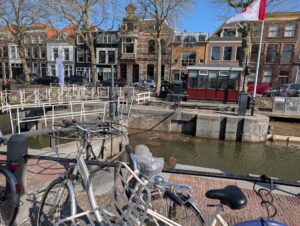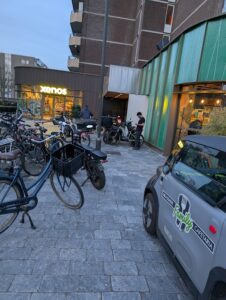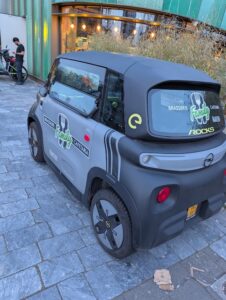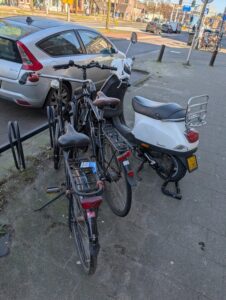
The book is changing as I write this.
One point has become clear. Dutch people want to go fast, just like Americans. They want to get from Point A to Point B, with all the stuff they’ll need at Point B, in the shortest possible time.
The time it takes to get from Point A to Point B, however, includes the time you sit behind other people. It includes time to get to your vehicle, and time you need to secure it at the other end of your journey. Time includes the money to pay for all of this.
In a dense, medieval city like Utrecht, going fast means taking a bike. At 10 miles per hour, in a city just a few miles on each side, bike travel time is minimal. You can leave a bike anywhere. Don’t worry about security. Everyone has a bike. It’s practically a free good.
But when you move a mile or two from town, you want an e-bike. You’ll spend more time securing it, you’ll need a lock, but your transit time will be less, and you won’t end up sweating as on a manual bike. You spend more up-front, and you need a way to recharge it, but you make the trade-offs because you want to go fast. Maybe, if you have kids and large loads, you spring for a cargo bike.
The hottest thing on the Utrecht streets is the mobility scooter. It’s an electric wheelchair for those who can’t walk far. It goes 15 mph on the bike paths. You’ll have to find somewhere to put it, however.
Distance, Price, and Size

All the cool kids in Maarssen are on e-mopeds. They scoot up and down the bike paths, they don’t wear helmets, they don’t need a license, yet. They’re a hazard to bikes and e-bikes, and many want them banned. The cost isn’t much higher than a regular e-bike, if you shop carefully. If kids go into town, they accept having to find space and a way to lock it, but that’s a fair trade-off for them, if not for others, and they’re not going into town much anyway.
When kids get old enough, when they can afford it, they want a motorcycle. Again, it costs more, it takes more space to park, finding the space takes time and money, but they go further, and fast. The speed means you need special clothing, and a helmet. You need a license, and classes, and (still, for the most part) gasoline. You need a place to put it. You also make a lot of noise, and pollution. These last costs are passed on to others. But Utrecht has a lot of motorcycles.
There are also many people in the Netherlands who never go near the cities. A car-focused life can still be practiced here. Maybe the car is smaller, and drivers here are no fonder of the trade-offs than drivers in Atlanta. They put up with them, when they go to town, because not having all those other people in cars lets them go fast.
Speed, Load, Parking, Cost

In America, Sunbelt cities are just now finding this an issue. People in cars are angry about it. They don’t want to slow down, and they don’t want to pay for parking. They demand free space for their vehicles because that’s what they are accustomed to in the suburbs. Most cities, outside their central cores, are still suburbs.
But it doesn’t matter. The trade-offs are still there. Density raises the cost of car travel dramatically. Without bikes, you’re stuck in traffic because you are traffic. Bicyclists and fietsers who live close, who make the trade-offs for time need less space than you do, but they still need some space to be safe.
The Netherlands gives people that space. But the trade-offs remain. I can probably get to Amsterdam on my rented e-bike. It’s about 20 miles. But that’s nearly 2 hours each way. Any further and I’ll take the train. I would love to ride an e-moped, but visitors aren’t allowed on them, so a small child will zoom past me as I go. I wonder, will the Dutch ever trust me the way they do their kids?
The Solution

But there remains the war around density. The trade-offs remain. There are always trade-offs if you want to go fast.
Computers and networks can reduce the need for trade-offs when we start thinking of transportation as a verb, not a noun. We can have self-driving cars, e-bikes and scooters sized for the trip and the load we’re carrying. They can get us where we’re going and then disappear to serve someone else. Wireless networks, small transponders, GPS mapping, and the coming wonders of AI can, in theory, combine to make the trade-offs disappear, maybe in your lifetime.
This revolution is just getting started, and this is what I am looking forward to. That’s the story of my life, looking forward.









